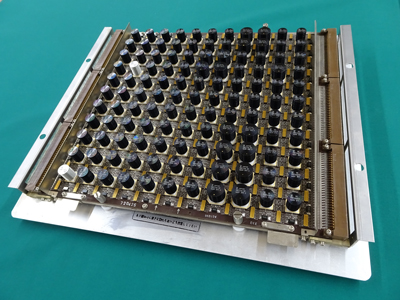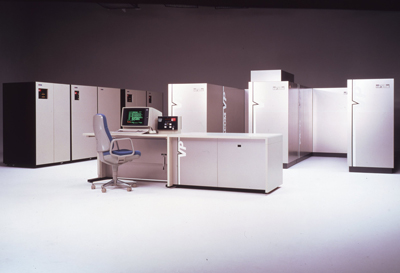

- Home >
- Artifacts of IP Heritage >
- 2019 >
- MCC board of FACOM VP Series E models
MCC board of FACOM VP Series E models


| Manufactured in | 1987 |
|---|---|
| Manufactured by | Fujitsu Limited |
| Owner | Fujitsu Limited |
| Location of historical materials | Fujitsu Numazu Complex 140 Miyamoto Numazu-shi, Shizuoka Japan 410-0396 |
| Visitor information | Not open to the public (Ask for a visit) |
| Contact | GENERAL AFFAIRS DEPT.
Email: fj-archives-history@dl.jp.fujitsu.com |
MCC (Multi-Chip Carrier) high-density mounting circuit board incorporated in Fujitsu's VP series supercomputers, which achieved performance exceeding 1GFLOPS for the first time in the world.
FACOM VP series began with its announcement of VP-100/200 in 1982 and its VP-400 was the first computer in the world to record over 1GFLOPS at the National Aerospace Laboratory (NAL, now JAXA) in 1985.
The technology of VP series is the same as that of M-series M-382/M-380, which was introduced in 1981. This MCC board can accommodate total 121 of 400-gate LSIs, 1,300-gate LSIs, and 4 Kibit RAM modules. The vector processing unit of VP-400 consists of five 3D stack structures, which are cubes with sides of 50 cm in length and accommodate up to 13 MCC boards.
The memory bandwidth of VP-400 was the same as that of VP-200, but the number of vector arithmetic units had been doubled. This approach was a reasonable way to achieve 1 GFLOPS required by NAL, and its computational fluid dynamics simulation fully exploited its potential performance despite this change. In 1987, introducing new "Multiply and Add" instructions that became commonplace in modern CPUs, "E Model" enhanced its performance by 1.5 times to attain 1.7 GFLOPS.
By introducing these architectural innovations that have now developed into standard extensions, the MCC technology originally developed for large general-purpose machines had long been adopted in the VP series.
